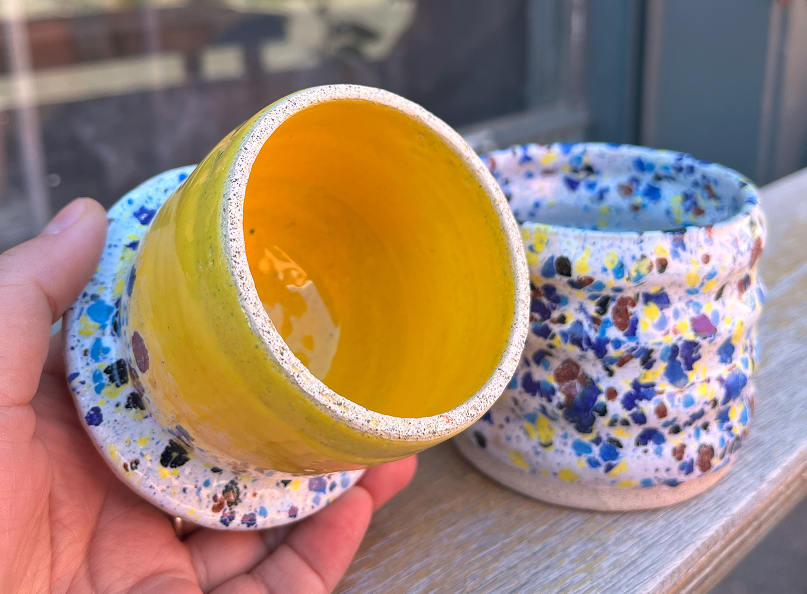Understanding Underglazes
Underglazes are colored materials used to decorate pottery before glazing. They let you paint, draw, or add designs directly onto greenware or bisque-fired clay. What’s great about them is they stay put during firing—they don’t run or blur—so they’re perfect for detailed work.
You can use underglazes in many ways: for sgraffito, mishima, painting, sponging, or even airbrushing. They come in lots of colors and can be layered for depth and texture, making them a favorite tool for both functional and decorative pieces.
Underglazes are different from overglazes, which go on top of a fired glaze and give shiny or metallic finishes. Knowing when and how to use each one can really expand your decorating possibilities.
What Exactly Is Underglaze?
Underglaze is a blend of clay, water, and pigments used to add color and decoration to pottery before the final glaze is applied. It’s designed to stay vibrant and stable through the firing process, making it perfect for detailed artwork on ceramics.
Why Use Underglaze?
Underglaze is popular because it lets you create precise, colorful designs that won’t run or fade during firing. It’s easy to work with and gives artists the freedom to decorate pottery with everything from simple patterns to intricate illustrations.
Chemistry of Underglaze
Here's a summary of the main components:
- Clay: Forms the base structure and helps the underglaze stick to the pottery.
- Flux: Assists the underglaze in melting and bonding with the clay body when fired. Examples include borax or low-temperature frits.
- Pigments: Metallic oxides that add color. Cobalt gives blue, copper provides green or red, and chrome results in green.
- Fillers: Substances like silica or alumina that improve the texture and shine of the underglaze.
- Binder: A material, such as gum or methyl cellulose, that ensures the underglaze applies smoothly and doesn't separate.
- Water: Used to achieve the right consistency for application.

What’s the Difference Between Glaze and Underglaze?
- Glaze creates a protective, glossy coating on the pottery’s surface. Read more about glazes here - Understanding Ceramic Glazes
- Underglaze provides stable, vibrant color beneath the glaze layer, letting your designs shine through.


How to Use Underglazes
There are many fun and creative ways to apply underglaze — each produces different textures and effects. Here are some favorites:
1. Brushing
Classic and reliable. Use a soft brush to paint smooth, controlled strokes. Great for detailed images or solid color areas. For rich color, apply 2-3 thin coats, letting each dry first.

2. Sponging
Create soft textures by dabbing with a sponge. Perfect for rustic or nature-inspired backgrounds.
3. Dipping
Submerge your piece in underglaze for quick, even coverage — ideal for base coats or large batches.
4. Spraying
Use an airbrush or spray gun to mist underglaze on your pottery. Ideal for subtle gradients and soft color transitions.
5. Stamping & Stenciling
Apply underglaze with stamps or through stencils to make repeated patterns, motifs, or lettering with clean lines.
6. Bubble Underglazing
Mix underglaze with a little dish soap, blow bubbles with a straw, and press your pottery on top. When bubbles pop, they leave fun, organic patterns!

7. Sgraffito
Apply underglaze, let it dry slightly, then carve through it to reveal the clay beneath. Great for line drawings and fine textures.
8. Mishima (Inlay)
Carve fine lines into clay, fill them with contrasting underglaze, then scrape off the excess. This creates elegant, sharp designs.
9. Marbling
Swirl different underglaze colors together and apply to your piece for beautiful flowing, marbled effects.

10. Masking & Tape Resist
Use painter’s tape or wax resist to block areas before painting. When removed, you get crisp, sharp edges — perfect for geometric or text designs.
11. Watercolor Technique
Dilute underglaze with water and paint like a watercolor. This creates soft, blended effects ideal for landscapes or abstract art.
Bonus Tip: Mix and Match Techniques!
Feel free to combine methods — brush over a sprayed base, carve into stamped patterns, or layer sgraffito on top of marbling. Mixing techniques adds depth and personal flair to your pottery.

When Can You Apply Underglaze?
You can apply underglaze at different stages in your pottery process, each with its own pros and cons:
On Greenware:
This means painting on unfired, still-soft clay. It’s easier to fix mistakes by wiping or smoothing, but be careful—greenware is very fragile and can break easily.
On Bisque Ware:
Here, you apply underglaze after the first firing, when your pottery is stronger but still porous. It’s less likely to break, but mistakes are harder to clean up. Once you’ve painted your design, be sure to cover it with a clear glaze without smudging your artwork.
Conclusion
Underglazes are a go-to for ceramic artists who want to add vibrant colors and detailed designs to their work. They can turn even the simplest forms into something truly eye-catching. Once you get the hang of how they work, they open up endless creative possibilities.
The best way to learn? Experiment. Try out different brands, techniques, and firing temperatures. With time and practice, you’ll start to see your style emerge—and your pieces will stand out with personality and flair.











.png)
.png)




